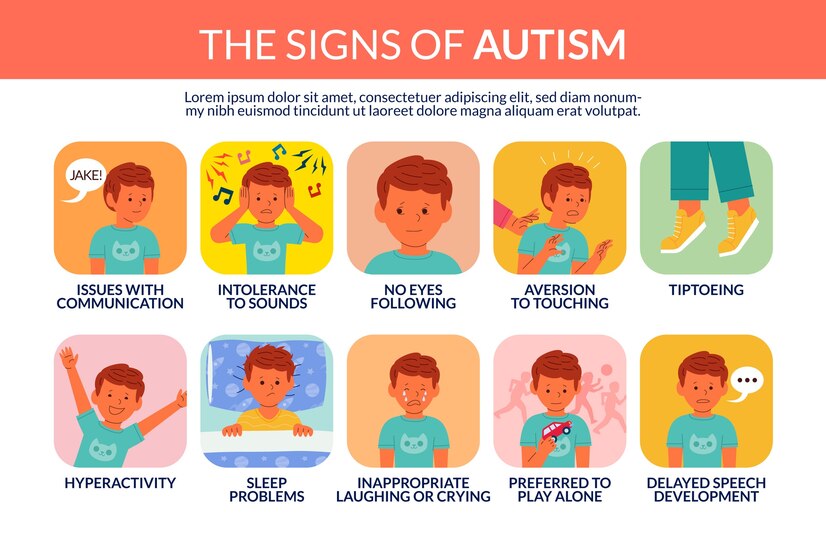What Is Autism Spectrum Disorder?
Autism Spectrum Disorder (ASD) is a lifelong neurodevelopmental condition marked by two main characteristics:
- Challenges in social interaction and communication
- Restricted or repetitive behaviors or intense interests
These traits vary widely—from mild to significant—and how they present depends on the individual.
1. Social Communication and Interaction
Autism can affect how someone connects with others in several ways:
Reduced Eye Contact and Facial Expression Use
People with autism may avoid eye contact, show minimal facial reactions, or seem unaware of unspoken social signals .
Delayed Speech or Language Differences
They may talk late, stop speaking after starting, or struggle with conversation. You might hear echolalia—repeating phrases verbatim—either right away or hours later .
Trouble Sustaining Conversations
Even when speaking, they often find it hard to keep a back-and-forth exchange going and may not start conversations on their own .
Difficulty Understanding Social Context
Reading facial expressions, body language, jokes, or sarcasm can be hard. They may not clearly signal their own feelings and may not react typically when others express emotions .
Limited Sharing of Interests or Emotions
They might not point to show you something exciting or act surprised. Some don’t seek to share experiences emotionally, which impacts early social bonding .

2. Restricted, Repetitive Behavior and Intense Interests
These behaviors play a central role in ASD diagnosis. Examples include:
Repetitive Motor Patterns (Stimming)
Rocking, hand flapping, spinning, toe walking, or finger flicking—especially when anxious or excited
Strict Routine or Predictability Needs
Strong preference for same routines—like food, clothes, or daily paths. Even minor changes can cause distress
Deep Fixations on Objects or Topics
Intense, narrow interests (trains, numbers, weather) that last months or even years .
Detailed Over Focus
Focusing on small parts of things—like wheels or textures—rather than seeing them as a whole
Unusual Sensory Reactions
Extreme reaction to sounds, lights, textures, smells, or tastes. They might be overwhelmed by or seek out sensory input .
3. Other Common Traits
People with autism often show related characteristics that affect day-to-day life:
- Delayed motor or learning skills—such as handwriting or balanced movement.
- Hyperactivity or attentional struggles—sometimes overlapping with ADHD
- Sleep and eating irregularities, gastrointestinal sensitivities.
- Emotional reactions—including anxiety, resistance to change, or mood swings .
- Seizures or medical conditions that sometimes co-occur .
When Do Signs Appear?
-
Most signs show up in early childhood—before age three, often as early as year one .
-
Some may not be obvious until later, especially when demands for social interaction grow or masking behaviors develop.
Male vs. Female Presentation
-
Boys often display visible stimming and are diagnosed earlier.
-
Girls may mask symptoms—imitating social behavior. They tend to be diagnosed later and less often
What to Do If You Recognize the Signs
- Observe carefully across several behaviors, not just one.
- Discuss concerns with a healthcare provider, such as a pediatrician or developmental specialist.
- Ask for a screen—standard tools (like M‑CHAT) can identify early developmental issues.
- Get a full evaluation, which may involve multiple professionals (psychologists, speech therapists).
- Begin early support, such as speech, occupational, behavioral, or educational therapies.
- Use practical tools: visual schedules, social stories, sensory supports, transition warnings.

Summary: Spotting Autism
Key Warning Signals:
-
Limited social engagement and communication
-
Repetitive behaviors, strict routines, intense focuses
-
Uncommon sensory reactions
-
Developmental delays in speech or motor skills
Take Action Early
Detecting signs of autism early—ideally by age 2 or 3—can unlock powerful support systems. The CDC’s “Learn the Signs. Act Early.” initiative offers free tools like milestone checklists and screening apps. Remember, ADHD, speech delay, and anxiety may look similar—only full professional evaluation can clarify.
Understanding these signs—when, how, and why—is your first step toward meaningful support. If any resonated, don’t hesitate. Act now: speak with a professional, seek an evaluation, and remember: early attention creates better outcomes.
